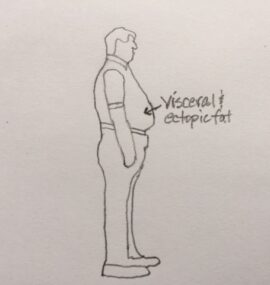Visceral and ectopic versus subcutaneous body fat
Aerobic xercise helps reduce visceral fat
With fat, location matters. Visceral fat occurs within the abdominal cavity. Subcutaneous fat occurs just beneath the skin. Researchers used data from 3,001 participants in the Framingham Heart Study Offspring and Third-Generation cohorts to determine links between these two types of fat and metabolic risk factors for diseases such as type 2 diabetes. Compared to subcutaneous fat, visceral fat more strongly predicted most metabolic risk factors. For example, less than 1 percent of normal weight women in the lowest quartile of visceral fat had the metabolic syndrome, compared to 8 percent of normal-weight women in the highest quartile of visceral fat. Visceral fat appears to be uniquely pathogenic.
Accumulating evidence suggests that excess visceral fat predicts metabolic disturbances that arise from ectopic fat stored in the liver, pancreas, heart, and skeletal muscles. Thus, reducing visceral fat may reduce metabolic problems. Could exercise reduce visceral fat? A systematic review and meta-analysis of 15 trials evaluated effects of different exercise regimes of at least 8 weeks duration on visceral fat of persons with overweight or obesity. Overall, exercise led to a significant decrease in visceral fat. Aerobic exercise proved to be most effective, while the effects of strength training or combined aerobic and strength training were not significant. Moderate and high-intensity training predicted lower visceral fat, while light-intensity training did not. These positive results occurred without caloric restrictions. A program of moderate- or high-intensity aerobic training can reduce visceral fat for persons with overweight or obesity and may reduce their risk of cardiovascular disease and type 2 diabetes.
Health providers often prescribe exercise and a low-calorie diet for persons with obesity to lose weight. While lifestyle changes commonly seek to reduce overall body weight, visceral fat more stronger predicts illness and death. Researchers performed a meta-analysis of 117 studies to assess the effects of exercise or diet on visceral fat. Both exercise and diet reduced visceral fat mass. Diet caused a larger loss of overall body weight than exercise. Without weight loss, exercise led to a 6 percent loss of visceral fat, while diet led to minimal loss (1 percent). Both exercise and diet reduce visceral fat. Despite a larger effect of diet on total body weight loss, exercise tends to reduce visceral fat more than diet. Total body weight loss does not necessarily reflect changes in visceral fat and maybe a poor marker of effective lifestyle choices.
Excess body fat, especially visceral fat, predicts higher risk of cardiovascular disease and type 2 diabetes. Small amounts of ectopic fat that permeate the liver, pancreas, heart, and skeletal muscles lead to increased insulin resistance (inability of insulin to enter cells), higher blood insulin and blood sugar concentrations, and increased risk of type 2 diabetes. Key lifestyle changes that help prevent type 2 diabetes and cardiovascular disease include Keep Moving and Eat Better. A systematic review and meta-analysis found that regular exercise can decrease visceral and liver fat and improve cardiovascular health.
A more recent systematic review and meta-analysis included 24 studies that used aerobic exercise or progressive resistance exercise or both to reduce visceral and liver fat of adults with type 2 diabetes. Pooled data from 13 of these studies showed that moderate to vigorous exercise predicted significantly reduced visceral fat, even though none of the individual studies showed significant decreases. (Pooling data increases sample size and statistical power and increases the likelihood of finding significant effects.) Data pooled from four studies showed a barely non-significant exercise-induced reduction of liver fat. Sub-analyses showed that aerobic exercise but not progressive resistance training or a combination of aerobic and resistance training predicted visceral fat loss. In addition, aerobic exercise led to less significantly less visceral fat even without overall body weight loss. This good news story showed that moderate or vigorous aerobic exercise conducted several times a week may reduce visceral fat, insulin resistance, and blood sugar, thereby lessening the risk of or possibly reversing type 2 diabetes—even without losing body weight.
Several decades of research show that visceral fat predicts increased risk of dying from cardiovascular and metabolic diseases, such as type 2 diabetes. Recent research suggests that ectopic fat deposited in the liver and heart muscle may increase atherosclerosis and cardiometabolic risk. Interestingly, body-mass index (BMI) does not adequately predict health risk, because BMI does not distinguish visceral and ectopic fat from subcutaneous fat. Reducing visceral and ectopic fat can improve blood sugar control regardless of body weight. Excess visceral fat may lead to health problems because: 1) of its unique metabolic properties, 2) it induces inflammation, and 3) it serves as a marker of ectopic fat.
When the body’s ability to store fat under the skin is saturated, additional fat gets stored in the abdominal area as visceral fat, some of which may later be stored as ectopic fat in organs that usually don’t store fat, such as the liver, pancreas, heart, and skeletal muscles. The amount of under-the-skin fat storage capability ability varies among people. Individuals with relatively small under-the-skin fat storage capacities have low personal fat storage thresholds. Such folks can have relatively little body fat, have a healthy-weight BMI, yet have high risk of cardiometabolic diseases because their excess fat ends up as visceral and/or ectopic fat. Those of us with a beer belly would do well to shrink it with aerobic exercise and a better diet.








